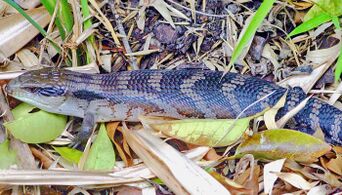Biology:Tiliqua scincoides
| Tiliqua scincoides | |
|---|---|

| |
| A common blue-tongued skink in Killcare, Australia | |
| Scientific classification | |
| Domain: | Eukaryota |
| Kingdom: | Animalia |
| Phylum: | Chordata |
| Class: | Reptilia |
| Order: | Squamata |
| Family: | Scincidae |
| Genus: | Tiliqua |
| Species: | T. scincoides
|
| Binomial name | |
| Tiliqua scincoides (White, 1790)
| |
| Subspecies | |
|
3, see text | |
Tiliqua scincoides (common blue-tongued skink,[2] blue-tongued lizard, common bluetongue[3]) is a species of skink. It is native to Australia as well Tanimbar Island (Maluku Province, Indonesia). [3]
Subspecies
There are three subspecies:[3]
- Tiliqua scincoides scincoides – eastern blue-tongued skink (southern/eastern Australia)
- Tiliqua scincoides intermedia – northern blue-tongued skink (northern Australia)
- Tiliqua scincoides chimaera – Tanimbar blue-tongued skink (Maluku Province, Indonesia)
Description
This is a large species of terrestrial blue tongue measuring upwards of 60 centimetres in length and over 1 kilogram in mass. It has a stout body and short legs.[2] It is variable in color but generally has a banded pattern. The tongue is blue-violet[4] to cobalt blue in color.[5] The tongue is used, like most animals in the order Squamata, to collect micro molecules to deliver to sensory organs as a "smell" sense using the tip. The tongue of the blue-tongued skink is also useful in catching prey, as it is coated in a sticky mucus to preserve surface tension in motion to draw an insect back into the mouth.[6] Due to its characteristic blue tongue and its curious nature, it is a popular companion animal in Western countries.[7]
This lizard is diurnal, active during the day. It is omnivorous, feeding on insects, snails, frogs, other reptiles, small birds, small mammals, carrion, some plant material, fruits, and other vegetation.[2][8][9] It is ovoviviparous, and a live bearing reptile. The female's litter can have a range from 5 to 25 live young per litter with Tiliqua scincoides scincoides being known to carry the largest litters.[4] This species is known to live over 30 years. It is an adaptable animal, often finding habitat in urban and suburban areas, including residential areas of Sydney.[2] The lizard is considered beneficial in these areas, with its appetite for garden pests such as slugs and snails.[4]
When threatened it may hiss and reveal its blue tongue, startling potential predators.[4]
There are many localities and established color variations for each. Eastern blue tongues can have a green or yellow phase, they can have eye bands or not, and look different coming from the Brisbane area and others. In captivity, breeders have expressed albinism and hyper melanism. Northerns are either classic/standard looking or speckled from the Kimberley region and Prince Regent National Park. In captivity, breeders have expressed exaggerated colorations that can be red, yellow, orange, caramel, white, and others. Tanimbar blue tongues are the most glossy and often seen in a gold or silver phase. Tanimbar and Kimberley Northerns are known for being more aggressive in the wild than other species.
Gallery
References
- ↑ Shea, G. (2017). "Tiliqua scincoides". IUCN Red List of Threatened Species 2017: e.T109481538A109481555. doi:10.2305/IUCN.UK.2017-3.RLTS.T109481538A109481555.en. https://www.iucnredlist.org/species/109481538/109481555. Retrieved 6 October 2021.
- ↑ 2.0 2.1 2.2 2.3 Koenig, Jennifer; Shine, Richard; Shea, Glenn (2002). "The dangers of life in the city: patterns of activity, injury and mortality in suburban lizards (Tiliqua scincoides)". Journal of Herpetology 36 (1): 62–68. doi:10.1670/0022-1511(2002)036[0062:TDOLIT2.0.CO;2]. http://sydney.edu.au/science/biology/shine/publications/reprints_legal/314lifeinthecity.pdf.
- ↑ 3.0 3.1 3.2 Tiliqua scincoides at the Reptarium.cz Reptile Database. Accessed 18 May 2017.
- ↑ 4.0 4.1 4.2 4.3 Tiliqua scincoides. Australian Reptile Online Database.
- ↑ Abbate, F.; Latella, G.; Montalbano, G.; Guerrera, M. C.; Germanà, G. P.; Levanti, M. B. (2009). "The lingual dorsal surface of the blue‐tongue skink (Tiliqua scincoides)". Anatomia, Histologia, Embryologia 38 (5): 348–350. doi:10.1111/j.1439-0264.2009.00952.x. PMID 19769569.
- ↑ Sack, Jeffrey D. (August 2022). "True Facts: Snake and Lizard Tongues". The American Biology Teacher (University of California Press) 84 (6): 378. doi:10.1525/abt.2022.84.6.378. https://online.ucpress.edu/abt/article/84/6/378/189894/True-Facts-Snake-and-Lizard-Tongues. Retrieved 2023-05-17.
- ↑ Jirik, Kate (2018). "Eastern Blue-tongued Skink (Tiliqua scincoides) Fact Sheet". San Diego Zoo Wildlife Alliance. https://ielc.libguides.com/sdzg/factsheets/eastern-blue-tongued-skink.
- ↑ "Tiliqua scincoides (Common Bluetongue, Eastern Bluetongue, Northern Bluetongue, Eastern Blue-Tongued Lizard)". https://animaldiversity.org/accounts/Tiliqua_scincoides/.
- ↑ "LibGuides: Eastern Blue-tongued Skink (Tiliqua scincoides) Fact Sheet: Diet & Feeding". https://ielc.libguides.com/sdzg/factsheets/eastern-blue-tongued-skink/diet.
Wikidata ☰ Q781954 entry
 |




